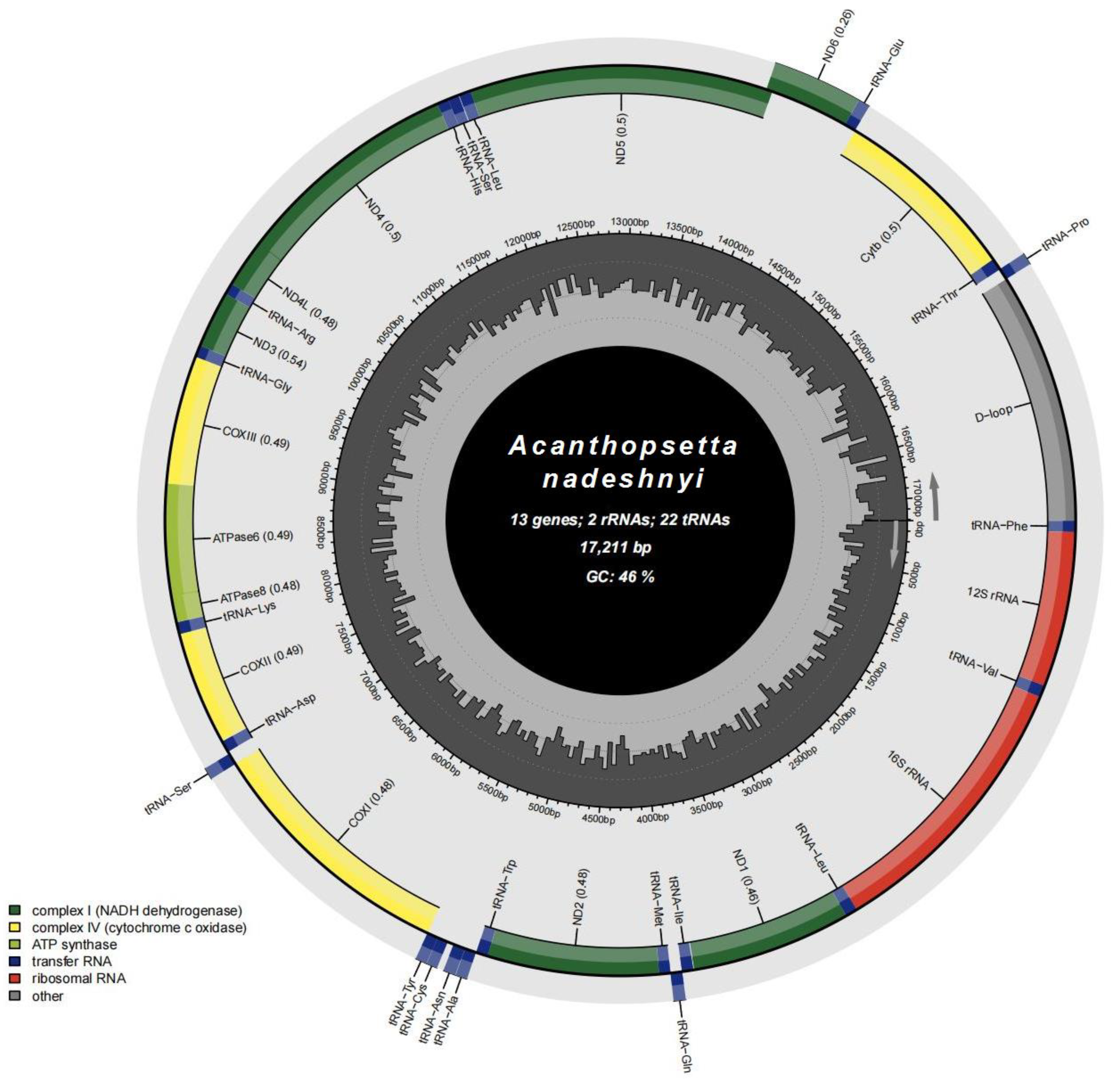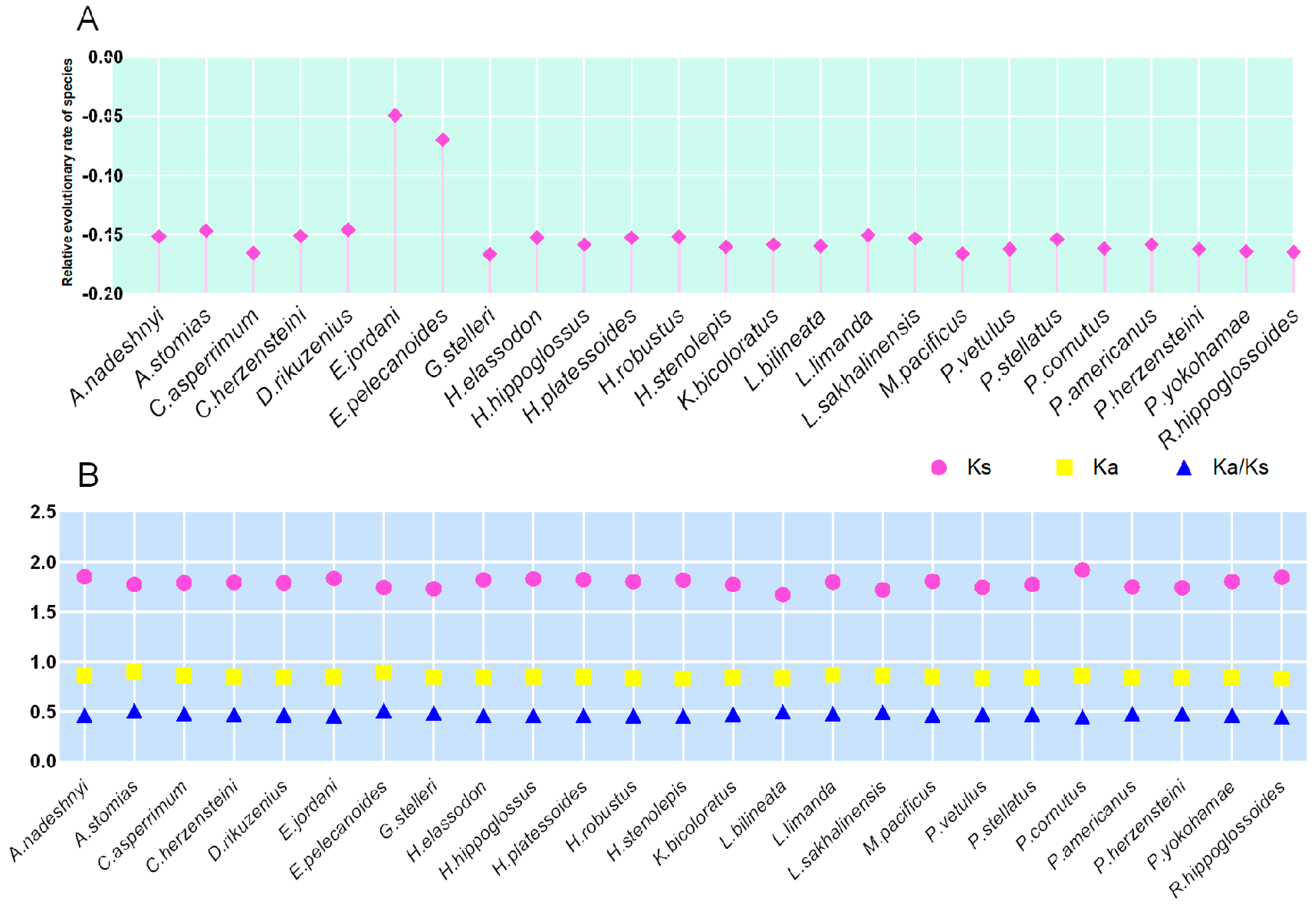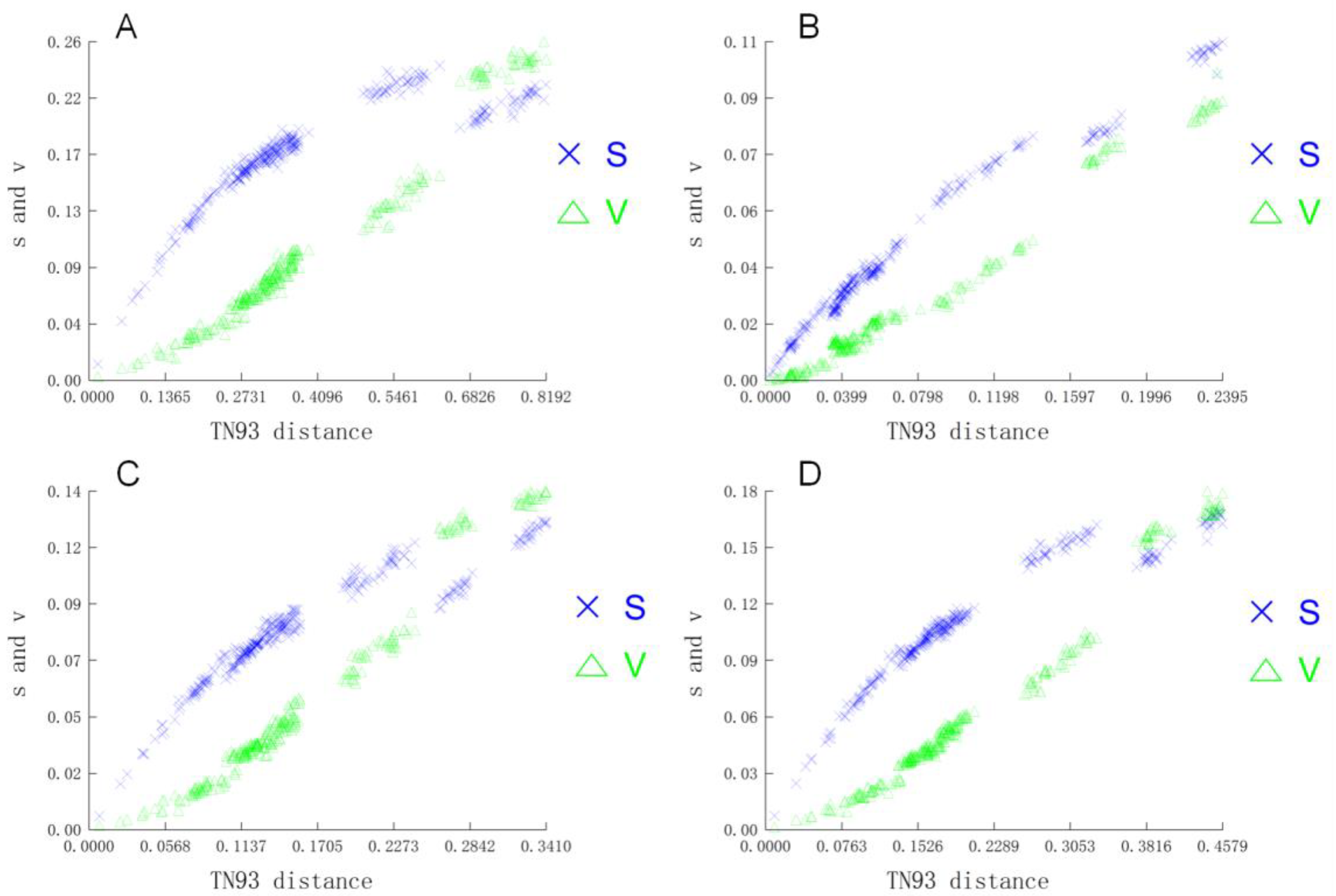Mitochondrial Genome Characteristics Reveal Evolution of Acanthopsetta nadeshnyi (Jordan and Starks, 1904) and Phylogenetic Relationships
Abstract
1. Introduction
2. Materials and Methods
2.1. Sample Collection, DNA Extraction, and PCR Amplification and Sequencing
2.2. Sequence Analysis and Assembly and Mitochondrial Genome Annotation
2.3. Amino Acid Composition and Nucleotide Substitution Saturation Index of PCGs
2.4. Relative Evolutionary Rate Analysis
2.5. Divergence Time Estimation
2.6. Phylogenetic Tree Construction
3. Results and Discussion
3.1. Characteristics, Structure, and Overlapping of the Mitogenomes
3.2. Protein-Coding Genes and Codon Usage
3.3. Mitogenome Mutations and Evolutionary Relationships in Pleuronectidae
3.4. Divergence Time and Phylogenetic Analysis
4. Conclusions
Supplementary Materials
Author Contributions
Funding
Institutional Review Board Statement
Informed Consent Statement
Data Availability Statement
Conflicts of Interest
References
- Oliveira, M.T.; Haukka, J.; Kaguni, L.S. Evolution of the Metazoan Mitochondrial Replicase. Genome Biol. Evol. 2015, 7, 943–959. [Google Scholar] [CrossRef] [PubMed]
- Huang, Y.K.; Liu, B.J.; Meng, F.; Wang, Q.; Zhu, K.H.; Zhang, J.S.; Jing, F.; Xia, L.P.; Liu, Y.F. The complete mitochondrial genome of Poecilia formosa (Poecilia, Cyprinodontidae) and phylogenetic studies of cyprinodontiformes. Mitochondrial DNA Part B-Resour. 2019, 4, 3820–3821. [Google Scholar] [CrossRef] [PubMed]
- Lü, Z.M.; Zhu, K.H.; Jiang, H.; Lu, X.T.; Liu, B.J.; Ye, Y.Y.; Jiang, L.H.; Liu, L.Q.; Gong, L. Complete mitochondrial genome of Ophichthus brevicaudatus reveals novel gene order and phylogenetic relationships of Anguilliformes. Int. J. Biol. Macromol. 2019, 135, 609–618. [Google Scholar] [CrossRef] [PubMed]
- Miya, M.; Takeshima, H.; Endo, H.; Ishiguro, N.B.; Inoue, J.G.; Mukai, T.; Satoh, T.P.; Yamaguchi, M.; Kawaguchi, A.; Mabuchi, K.; et al. Major patterns of higher teleostean phylogenies: A new perspective based on 100 complete mitochondrial DNA sequences. Mol. Phylogenet. Evol. 2003, 26, 121–138. [Google Scholar] [CrossRef] [PubMed]
- De Giorgi, C.; Saccone, C. Mitochondrial genome in animal cells. Structure, organization, and evolution. Cell Biophys. 1989, 14, 67–78. [Google Scholar] [CrossRef] [PubMed]
- Yuan, L.L.; Liu, H.Y.; Ge, X.Y.; Yang, G.Y.; Xie, G.L.; Yang, Y.X. A Mitochondrial Genome Phylogeny of Cleridae (Coleoptera, Cleroidea). Insects 2022, 13, 118. [Google Scholar] [CrossRef] [PubMed]
- Liu, D.; Guo, H.L.; Zhu, J.L.; Qu, K.; Chen, Y.; Guo, Y.T.; Ding, P.; Yang, H.P.; Xu, T.; Jing, Q.; et al. Complex Physical Structure of Complete Mitochondrial Genome of Quercus acutissima (Fagaceae): A Significant Energy Plant. Genes 2022, 13, 1321. [Google Scholar] [CrossRef] [PubMed]
- Yang, Y.Q.; Wang, J.J.; Dai, R.H.; Wang, X.Y. Structural Characteristics and Phylogenetic Analysis of the Mitochondrial Genomes of Four Krisna Species (Hemiptera: Cicadellidae: Iassinae). Genes 2023, 14, 1175. [Google Scholar] [CrossRef]
- Shelekhov, V.A.; Epur, I.V.; Balanov, A.A. Species Composition and Structure of Ichthyoplankton of the Northern Part of the Sea of Japan in Summer of 2017. J. Ichthyol. 2020, 60, 36–47. [Google Scholar] [CrossRef]
- Kravchenko, D.G.; Izmyatinsky, D.V. Estimating the Abundance of Bottom Fish at the Shelf and Continental Slope in Northern Primorye. J. Ichthyol. 2019, 59, 591–601. [Google Scholar] [CrossRef]
- Lim, H.K.; Jung, H.S.; Yoon, M.; Lee, S.-H.; Kim, D.S. Complete mitochondrial genomes of two Pleuronectid species: Clidoderma asperrimum and Verasper variegatus (Teleostei: Pleuronectiformes: Pleuronectidae). Mitochondrial DNA Part B 2019, 4, 3931–3932. [Google Scholar] [CrossRef] [PubMed]
- Wang, M.T.; Hou, Z.Y.; Li, C.; Yang, J.P.; Niu, Z.T.; Xue, Q.Y.; Liu, W.; Ding, X.Y. Rapid structural evolution of Dendrobium mitogenomes and mito-nuclear phylogeny discordances in Dendrobium (Orchidaceae). J. Syst. Evol. 2023, 61, 790–805. [Google Scholar] [CrossRef]
- Nosek, J.; Tomáska, L. Mitochondrial genome diversity:: Evolution of the molecular architecture and replication strategy. Curr. Genet. 2003, 44, 73–84. [Google Scholar] [CrossRef]
- Lee, S.J.; Koo, K.J.; Ryu, J.-H.; Yu, H.J.; Ji, H.-S.; Im, Y.-J. Molecular identification and morphological description of larvae for ten species of the family Pleuronectidae (Pleuronectiformes, PISCES) from Korea. J. Korean Soc. Fish. Ocean Technol. 2019, 55, 335–348. [Google Scholar] [CrossRef]
- Tinti, F.; Colombari, A.; Vallisneri, M.; Piccinetti, C.; Stagni, A.M. Comparative Analysis of a Mitochondrial DNA Control Region Fragment Amplified from Three Adriatic Flatfish Species and Molecular Phylogenesis of Pleuronectiformes. Mar. Biotechnol. 1999, 1, 20–24. [Google Scholar] [CrossRef] [PubMed]
- Chae, J.Y.; Kim, J.; Kang, T.W.; Kim, J.; Lee, H.H.; Kim, M.S. The study on the complete mitochondrial genome of Acanthopsetta nadeshnyi and its phylogenetic position. Mitochondrial DNA Part B-Resour. 2023, 8, 852–856. [Google Scholar] [CrossRef] [PubMed]
- Zhu, T.; Sato, Y.; Sado, T.; Miya, M.; Iwasaki, W. MitoFish, MitoAnnotator, and MiFish Pipeline: Updates in 10 Years. Mol. Biol. Evol. 2023, 40, msad035. [Google Scholar] [CrossRef] [PubMed]
- Tamura, K.; Stecher, G.; Kumar, S. MEGA11 Molecular Evolutionary Genetics Analysis Version 11. Mol. Biol. Evol. 2021, 38, 3022–3027. [Google Scholar] [CrossRef]
- Librado, P.; Rozas, J. DnaSP v5: A software for comprehensive analysis of DNA polymorphism data. Bioinformatics 2009, 25, 1451–1452. [Google Scholar] [CrossRef]
- Xia, X.; Xie, Z. DAMBE: Software package for data analysis in molecular biology and evolution. J. Hered. 2001, 92, 371–373. [Google Scholar] [CrossRef]
- Takezaki, N.; Rzhetsky, A.; Nei, M. Phylogenetic test of the molecular clock and linearized trees. Mol. Biol. Evol. 1995, 12, 823–833. [Google Scholar] [PubMed]
- Bouckaert, R.; Heled, J.; Kühnert, D.; Vaughan, T.; Wu, C.H.; Xie, D.; Suchard, M.A.; Rambaut, A.; Drummond, A.J. BEAST 2: A Software Platform for Bayesian Evolutionary Analysis. PLoS Comput. Biol. 2014, 10, e1003537. [Google Scholar] [CrossRef] [PubMed]
- Peng, Y.Y.; Yan, H.H.; Guo, L.C.; Deng, C.; Wang, C.L.; Wang, Y.B.; Kang, L.P.; Zhou, P.P.; Yu, K.Q.; Dong, X.L.; et al. Reference genome assemblies reveal the origin and evolution of allohexaploid oat. Nat. Genet. 2022, 54, 1248–1258. [Google Scholar] [CrossRef] [PubMed]
- Talavera, G.; Castresana, J. Improvement of phylogenies after removing divergent and ambiguously aligned blocks from protein sequence alignments. Syst. Biol. 2007, 56, 564–577. [Google Scholar] [CrossRef] [PubMed]
- Guindon, S.; Dufayard, J.F.; Lefort, V.; Anisimova, M.; Hordijk, W.; Gascuel, O. New Algorithms and Methods to Estimate Maximum-Likelihood Phylogenies: Assessing the Performance of PhyML 3.0. Syst. Biol. 2010, 59, 307–321. [Google Scholar] [CrossRef] [PubMed]
- Ronquist, F.; Teslenko, M.; van der Mark, P.; Ayres, D.L.; Darling, A.; Höhna, S.; Larget, B.; Liu, L.; Suchard, M.A.; Huelsenbeck, J.P. MrBayes 3.2: Efficient Bayesian Phylogenetic Inference and Model Choice Across a Large Model Space. Syst. Biol. 2012, 61, 539–542. [Google Scholar] [CrossRef] [PubMed]
- Sitnikova, T. Bootstrap method of interior-branch test for phylogenetic trees. Mol. Biol. Evol. 1996, 13, 605–611. [Google Scholar] [CrossRef] [PubMed][Green Version]
- Drummond, A.J.; Suchard, M.A.; Xie, D.; Rambaut, A. Bayesian Phylogenetics with BEAUti and the BEAST 1.7. Mol. Biol. Evol. 2012, 29, 1969–1973. [Google Scholar] [CrossRef] [PubMed]
- Huang, Y.K.; Liu, B.J.; Zhu, K.H.; Zhang, J.S.; Jing, F.; Xia, L.P.; Liu, Y.F. The complete mitochondrial genome of Gephyrocharax atracaudatus (Characiformes, Characidae) and phylogenetic studies of Characiformes. Mitochondrial DNA Part B-Resour. 2019, 4, 1901–1902. [Google Scholar] [CrossRef]
- Bulmer, M. The selection-mutation-drift theory of synonymous codon usage. Genetics 1991, 129, 897–907. [Google Scholar] [CrossRef]
- Ray, S.K.; Baruah, V.J.; Satapathy, S.S.; Banerjee, R. Cotranslational protein folding reveals the selective use of synonymous codons along the coding sequence of a low expression gene. J. Genet. 2014, 93, 613–617. [Google Scholar] [CrossRef]
- Friedman, J.R.; Nunnari, J. Mitochondrial form and function. Nature 2014, 505, 335–343. [Google Scholar] [CrossRef]
- Feng, P.; Zhao, H.B.; Lu, X. Evolution of mitochondrial DNA and its relation to basal metabolic rate. Mitochondrial DNA 2015, 26, 566–571. [Google Scholar] [CrossRef]
- Monroe, J.G.; Srikant, T.; Carbonell-Bejerano, P.; Becker, C.; Lensink, M.; Exposito-Alonso, M.; Klein, M.; Hildebrandt, J.; Neumann, M.; Kliebenstein, D.; et al. Mutation bias reflects natural selection in Arabidopsis thaliana. Nature 2022, 602, 101–105. [Google Scholar] [CrossRef]
- Robinson, J.; Kyriazis, C.C.; Yuan, S.C.; Lohmueller, K.E. Deleterious Variation in Natural Populations and Implications for Conservation Genetics. Annu. Rev. Anim. Biosci. 2023, 11, 93–114. [Google Scholar] [CrossRef] [PubMed]
- Tamura, K.; Nei, M. Estimation of the number of nucleotide substitutions in the control region of mitochondrial DNA in humans and chimpanzees. Mol. Biol. Evol. 1993, 10, 512–526. [Google Scholar] [PubMed]
- Blokzijl, F.; de Ligt, J.; Jager, M.; Sasselli, V.; Roerink, S.; Sasaki, N.; Huch, M.; Boymans, S.; Kuijk, E.; Prins, P.; et al. Tissue-specific mutation accumulation in human adult stem cells during life. Nature 2016, 538, 260–264. [Google Scholar] [CrossRef] [PubMed]
- Li, X.J.; Giorgi, E.E.; Marichann, M.H.; Foley, B.; Xiao, C.; Kong, X.P.; Chen, Y.; Korber, B.; Gao, F.; Gnanakaran, S. Emergence of SARS-CoV-2 through recombination and strong purifying selection. Sci. Adv. 2020, 6, eabb9153. [Google Scholar] [CrossRef]
- Ronquist, F.; Klopfstein, S.; Vilhelmsen, L.; Schulmeister, S.; Murray, D.L.; Rasnitsyn, A.P. A Total-Evidence Approach to Dating with Fossils, Applied to the Early Radiation of the Hymenoptera. Syst. Biol. 2012, 61, 973–999. [Google Scholar] [CrossRef]
- Zuckerkandl, E.; Pauling, L. Molecules as documents of evolutionary history. J. Theor. Biol. 1965, 8, 357–366. [Google Scholar] [CrossRef]
- Bromham, L.; Duchêne, S.; Hua, X.; Ritchie, A.M.; Duchêne, D.A.; Ho, S.Y.W. Bayesian molecular dating: Opening up the black box. Biol. Rev. 2018, 93, 1165–1191. [Google Scholar] [CrossRef] [PubMed]
- Pyron, R.A. Divergence Time Estimation Using Fossils as Terminal Taxa and the Origins of Lissamphibia. Syst. Biol. 2011, 60, 466–481. [Google Scholar] [CrossRef] [PubMed]
- Luo, A.; Ho, S.Y.W. The molecular clock and evolutionary timescales. Biochem. Soc. Trans. 2018, 46, 1183–1190. [Google Scholar] [CrossRef] [PubMed]
- Fuller, D.Q.; Denham, T.; Arroyo-Kalin, M.; Lucas, L.; Stevens, C.J.; Qin, L.; Allaby, R.G.; Purugganan, M.D. Convergent evolution and parallelism in plant domestication revealed by an expanding archaeological record. Proc. Natl. Acad. Sci. USA 2014, 111, 6147–6152. [Google Scholar] [CrossRef] [PubMed]
- Miller, K.G.; Browning, J.V.; Schmelz, W.J.; Kopp, R.E.; Mountain, G.S.; Wright, J.D. Cenozoic sea-level and cryospheric evolution from deep-sea geochemical and continental margin records. Sci. Adv. 2020, 6, eaaz1346. [Google Scholar] [CrossRef] [PubMed]
- Dalton, A.S.; Margold, M.; Stokes, C.R.; Tarasov, L.; Dyke, A.S.; Adams, R.S.; Allard, S.; Arends, H.E.; Atkinson, N.; Attig, J.W.; et al. An updated radiocarbon-based ice margin chronology for the last deglaciation of the North American Ice Sheet Complex. Quat. Sci. Rev. 2020, 234, 106223. [Google Scholar] [CrossRef]
- Batchelor, C.L.; Margold, M.; Krapp, M.; Murton, D.; Dalton, A.S.; Gibbard, P.L.; Stokes, C.R.; Murton, J.B.; Manica, A. The configuration of Northern Hemisphere ice sheets through the Quaternary. Nat. Commun. 2019, 10, 3713. [Google Scholar] [CrossRef]





| Species | Species | Family | Order | Accession No. |
|---|---|---|---|---|
| A. nadeshnyi | A. nadeshnyi | Acanthopsetta | Pleuronectidae | OQ791285 |
| Atheresthes stomias | A. stomias | Atheresthes | NC_083173 | |
| Cleisthenes herzensteini | C. herzensteini | Cleisthenes | NC_028021 | |
| Clidoderma asperrimum | C. asperrimum | Clidoderma | MK210570 | |
| D. rikuzenius | D. rikuzenius | Dexistes | NC_066467 | |
| Eopsetta jordani | E. jordani | Eopsetta | NC_083049 | |
| Glyptocephalus stelleri | G. stelleri | Glyptocephalus | NC_060723 | |
| Hippoglossoides elassodon | H. elassodon | Hippoglossoides | NC_082804 | |
| Hippoglossoides platessoides | H. platessoides | MN122825 | ||
| Hippoglossoides robustus | H. robustus | NC_082769 | ||
| Hippoglossus hippoglossus | H. hippoglossus | Hippoglossus | NC_009709 | |
| Hippoglossus stenolepis | H. stenolepis | NC_009710 | ||
| Kareius bicoloratus | K. bicoloratus | Kareius | NC_080271 | |
| Lepidopsetta bilineata | L. bilineata | Lepidopsetta | NC_083649 | |
| Limanda limanda | L. limanda | Limanda | OY755015 | |
| Limanda sakhalinensis | L. sakhalinensis | NC_082768 | ||
| Microstomus pacificus | M. pacificus | Microstomus | NC_082805 | |
| Parophrys vetulus | P. vetulus | Parophrys | OR482580 | |
| Platichthys stellatus | P. stellatus | Platichthys | NC_010966 | |
| Pleuronichthys cornutus | P. cornutus | Pleuronichthys | NC_022445 | |
| Pseudopleuronectes americanus | P. americanus | Pseudopleuronectes | NC_082555 | |
| Pseudopleuronectes herzensteini | P. herzensteini | NC_063673 | ||
| Pseudopleuronectes yokohamae | P. yokohamae | NC_028014 | ||
| Reinhardtius hippoglossoides | R. hippoglossoides | Reinhardtius | NC_009711 | |
| A. dabryanus | A. dabryanus | Acipenser | Acipenseridae | NC_036420 |
| E. pelecanoides | E. pelecanoides | Eurypharynx | Eurypharyngidae | AB046473 |
| S. lavenbergi | S. lavenbergi | Saccopharynx | Saccopharyngidae | AB047825 |
| Mitogenome | Position | Length | Amino | Start/Stop | Intergenic Region from to (bp) * | Strand # | |
|---|---|---|---|---|---|---|---|
| From/To | (bp) | Acid | Codon | ||||
| tRNA-Phe (F) | 1 | 68 | 68 | 0 | H | ||
| 12S RNA | 68 | 1017 | 950 | −1 | H | ||
| tRNA-Val (V) | 1018 | 1090 | 73 | 0 | H | ||
| 16S RNA | 1091 | 2804 | 1714 | 0 | H | ||
| tRNA-LeuUUA (L1) | 2807 | 2880 | 74 | 2 | H | ||
| ND1 | 2881 | 3855 | 975 | 325 | ATG/TAA | 0 | H |
| tRNA-Ile (I) | 3861 | 3930 | 70 | 5 | H | ||
| tRNA-Gln (Q) | 4000 | 3930 | 69 | −1 | L | ||
| tRNA-Met (M) | 4001 | 4069 | 69 | 0 | H | ||
| ND2 | 4069 | 5115 | 1047 | 349 | ATG/TAG | −1 | H |
| tRNA-Trp (W) | 5114 | 5185 | 72 | −2 | H | ||
| tRNA-Ala (A) | 5255 | 5187 | 69 | 1 | L | ||
| tRNA-Asn (N) | 5329 | 5257 | 73 | 1 | L | ||
| tRNA-Cys (C) | 5431 | 5367 | 65 | 37 | L | ||
| tRNA-Tyr (Y) | 5500 | 5433 | 68 | 1 | L | ||
| COX1 | 5502 | 7061 | 1560 | 520 | GTG/TAA | 1 | H |
| tRNA-SerUCA (S1) | 7132 | 7062 | 71 | 0 | L | ||
| tRNA-Asp (D) | 7147 | 7217 | 71 | 14 | H | ||
| COX2 | 7224 | 7914 | 691 | 230 | ATG/T | 6 | H |
| tRNA-Lys (K) | 7915 | 7987 | 73 | 0 | H | ||
| ATP8 | 7989 | 8156 | 168 | 56 | ATG/TAA | 1 | H |
| ATP6 | 8147 | 8830 | 684 | 228 | ATG/TAA | -10 | H |
| COX3 | 8830 | 9614 | 785 | 261 | ATG/TA | -1 | H |
| tRNA-Gly (G) | 9615 | 9686 | 72 | 0 | H | ||
| ND3 | 9687 | 10035 | 349 | 116 | ATG/T | 0 | H |
| tRNA-Arg (R) | 10036 | 10104 | 69 | 0 | H | ||
| ND4L | 10105 | 10401 | 297 | 99 | ATG/TAA | 0 | H |
| ND4 | 10395 | 11775 | 1381 | 460 | ATG/T | −7 | H |
| tRNA-His (H) | 11776 | 11845 | 70 | 0 | H | ||
| tRNA-SerAGC (S2) | 11846 | 11912 | 67 | 0 | H | ||
| tRNA-LeuCUA (L2) | 11919 | 11989 | 71 | 6 | H | ||
| ND5 | 11990 | 13840 | 1851 | 617 | ATG/TAA | 0 | H |
| ND6 | 14321 | 13803 | 519 | 173 | ATG/TAA | −38 | L |
| tRNA-Glu (E) | 14390 | 14322 | 69 | 0 | L | ||
| Cyt b | 14395 | 15535 | 1141 | 380 | ATG/T | 4 | H |
| tRNA-Thr (T) | 15536 | 15608 | 73 | 0 | H | ||
| tRNA-Pro (P) | 15678 | 15608 | 71 | −1 | L | ||
| Dloop | 15679 | 17211 | 1533 | 0 | H | ||
Disclaimer/Publisher’s Note: The statements, opinions and data contained in all publications are solely those of the individual author(s) and contributor(s) and not of MDPI and/or the editor(s). MDPI and/or the editor(s) disclaim responsibility for any injury to people or property resulting from any ideas, methods, instructions or products referred to in the content. |
© 2024 by the authors. Licensee MDPI, Basel, Switzerland. This article is an open access article distributed under the terms and conditions of the Creative Commons Attribution (CC BY) license (https://creativecommons.org/licenses/by/4.0/).
Share and Cite
Yang, L.-m.; Xue, J.-f.; Zhao, X.-m.; Ding, K.; Liu, Z.-w.; Wang, Z.-s.-y.; Chen, J.-b.; Huang, Y.-k. Mitochondrial Genome Characteristics Reveal Evolution of Acanthopsetta nadeshnyi (Jordan and Starks, 1904) and Phylogenetic Relationships. Genes 2024, 15, 893. https://doi.org/10.3390/genes15070893
Yang L-m, Xue J-f, Zhao X-m, Ding K, Liu Z-w, Wang Z-s-y, Chen J-b, Huang Y-k. Mitochondrial Genome Characteristics Reveal Evolution of Acanthopsetta nadeshnyi (Jordan and Starks, 1904) and Phylogenetic Relationships. Genes. 2024; 15(7):893. https://doi.org/10.3390/genes15070893
Chicago/Turabian StyleYang, Li-min, Jing-feng Xue, Xiao-man Zhao, Ke Ding, Zhao-wen Liu, Zhou-si-yu Wang, Jian-bing Chen, and You-kun Huang. 2024. "Mitochondrial Genome Characteristics Reveal Evolution of Acanthopsetta nadeshnyi (Jordan and Starks, 1904) and Phylogenetic Relationships" Genes 15, no. 7: 893. https://doi.org/10.3390/genes15070893
APA StyleYang, L.-m., Xue, J.-f., Zhao, X.-m., Ding, K., Liu, Z.-w., Wang, Z.-s.-y., Chen, J.-b., & Huang, Y.-k. (2024). Mitochondrial Genome Characteristics Reveal Evolution of Acanthopsetta nadeshnyi (Jordan and Starks, 1904) and Phylogenetic Relationships. Genes, 15(7), 893. https://doi.org/10.3390/genes15070893







